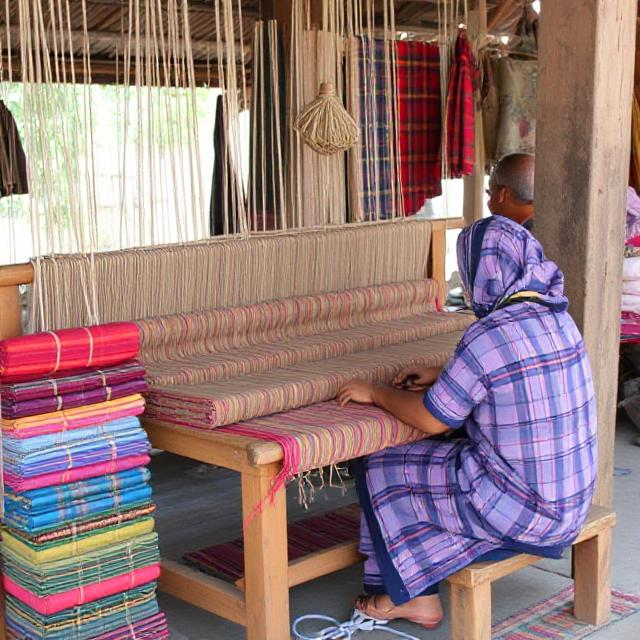Handloom in Bangladesh: The Heritage of Bangladesh
Bangladesh is a country rich in cultural heritage, with its traditional handloom and fabric industry playing a significant role in shaping its identity. The art of weaving has been an integral part of Bangladeshi culture for centuries, producing exquisite textiles that are cherished both locally and internationally. The country’s skilled artisans create handwoven fabrics that not only serve as a means of livelihood but also preserve the unique traditions of the region.
The History of Handloom in Bangladesh

The handloom industry in Bangladesh dates back thousands of years, with evidence of fine weaving practices found in ancient texts and historical artifacts. The Bengal region was historically known for producing the world-renowned Muslin fabric, an ultra-fine cotton textile that was highly valued by royalty and traders across the globe. Even though the British colonial period and industrialization led to the decline of muslin, the handloom tradition continued to thrive through other fabric varieties, such as Jamdani, Tant, and Khadi.
Major Handloom Fabrics of Bangladesh
1.Jamdani
Jamdani is one of the most exquisite and labor-intensive handloom fabrics of Bangladesh. Originating from Dhaka, this fabric is woven with intricate patterns and motifs, often inspired by nature. The fine muslin base and delicate designs make it a luxurious choice for sarees and other traditional attire. UNESCO has recognized Jamdani weaving as an Intangible Cultural Heritage of Humanity.
2.Tant
Tant fabric is a lightweight and airy cotton textile that is primarily woven in different parts of Bangladesh, including Tangail and Pabna. Known for its comfortable texture, bright colors, and elegant designs, Tant sarees are a staple in Bangladeshi households, especially during hot summers.
3.Khadi
Khadi is a hand-spun, handwoven fabric made from cotton, silk, or wool. It gained prominence during the Swadeshi movement in the Indian subcontinent. In Bangladesh, Khadi is widely used for making shirts, Panjabi ,kurtas, and scarves, offering a natural, breathable fabric with a rustic charm.
4.Silk Fabrics (Rajshahi Silk & Katan)
Bangladesh is also home to luxurious silk varieties like Rajshahi Silk and Katan. Rajshahi is famous for producing high-quality silk with a glossy finish, used in sarees, panjabis, and scarves. Katan, a type of woven silk fabric, is a popular choice for bridal and festive wear due to its durability and elegant appearance.
5.Gamcha
Gamcha is a handwoven cotton towel traditionally used across Bangladesh. While primarily a functional fabric, it has gained popularity in contemporary fashion, with designers incorporating it into modern apparel and accessories.
The Importance of Handloom in the Economy
The handloom industry in Bangladesh is a major source of employment, particularly in rural areas. Millions of weavers and artisans depend on this craft for their livelihood. Despite competition from machine-made textiles, handloom fabrics remain in demand due to their superior quality, unique craftsmanship, and cultural significance.
The government and various organizations are taking initiatives to support local weavers by promoting handloom products at national and international levels. Events like the National Handloom Fair provide a platform for artisans to showcase their work and reach wider markets.
Challenges Faced by the Handloom Industry
Despite its cultural and economic significance, the handloom sector in Bangladesh faces several challenges, including:
- Decline of Skilled Weavers: Younger generations are shifting to other professions due to low wages and lack of incentives.
- Competition with Machine-Made Textiles: Power looms and imported fabrics offer cheaper alternatives, affecting the demand for handwoven textiles.
- Lack of Modernization: Traditional weavers often lack access to advanced technology and proper marketing channels to compete in the global market.
Reviving the Handloom Industry
To preserve this centuries-old tradition, various steps can be taken:h
- Promoting Sustainable Fashion: Handloom fabrics are eco-friendly, making them an excellent choice for conscious consumers.
- Government Support: Providing subsidies, financial assistance, and training programs for weavers.
- Encouraging Youth Participation: By modernizing designs and marketing strategies, young designers can incorporate traditional fabrics into contemporary fashion.
- Expanding Export Markets: Showcasing Bangladeshi handloom products in international exhibitions and online platforms can boost global recognition.
Conclusion
The handloom industry of Bangladesh is a testament to the country’s rich heritage and craftsmanship. Despite facing challenges, it continues to be a symbol of tradition and elegance. By supporting and promoting handwoven fabrics, we not only empower the artisans but also ensure the preservation of Bangladesh’s cultural identity for future generations.
Below The 10 best handloom fabric products in Bangladesh, known for their exquisite craftsmanship and cultural significance:
1.Jamdani Saree
A UNESCO-recognized heritage fabric, Jamdani sarees are intricately woven with floral and geometric patterns, symbolizing luxury and tradition.
2.Tangail Tant Saree
Made from lightweight cotton, Tangail Tant sarees are breathable and ideal for Bangladesh’s climate, featuring elegant motifs and bright colors.
3.Rajshahi Silk Saree
Produced in Rajshahi, these silk sarees are known for their soft texture, rich sheen, and traditional designs, making them perfect for festive and bridal wear.
4.Katan Silk Saree
A popular choice for weddings, Katan silk is a durable and glossy fabric with intricate woven patterns that exude elegance and grandeur.
5.Khadi Fabric
A handwoven cotton fabric, Khadi is eco-friendly and highly breathable, used for making kurtas, shirts, scarves, and traditional attire.
6.Muslin Fabric
Once famed worldwide, Bangladeshi Muslin is an ultra-fine, lightweight cotton fabric that was worn by royalty and is now being revived.
7.Benarasi Saree
Though originally from Varanasi, India, the Benarasi saree has become a part of Bangladeshi tradition, featuring gold and silver zari work on silk.
8.Gamcha (Handwoven Cotton Towel)
A simple yet versatile handloom product, the gamcha is traditionally used as a towel but has found its way into modern fashion and home decor.
9.Handwoven Nakshi Kantha Fabric
Nakshi Kantha is a hand-stitched embroidered fabric used to make quilts, sarees, shawls, and even home décor items with intricate folk motifs.
10.Handloom Dupatta & Shawls
Made from cotton, silk, or muslin, handwoven dupattas and shawls add a touch of elegance to traditional and modern outfits.
Would you like details on where to buy these products or how to promote them on your website?




